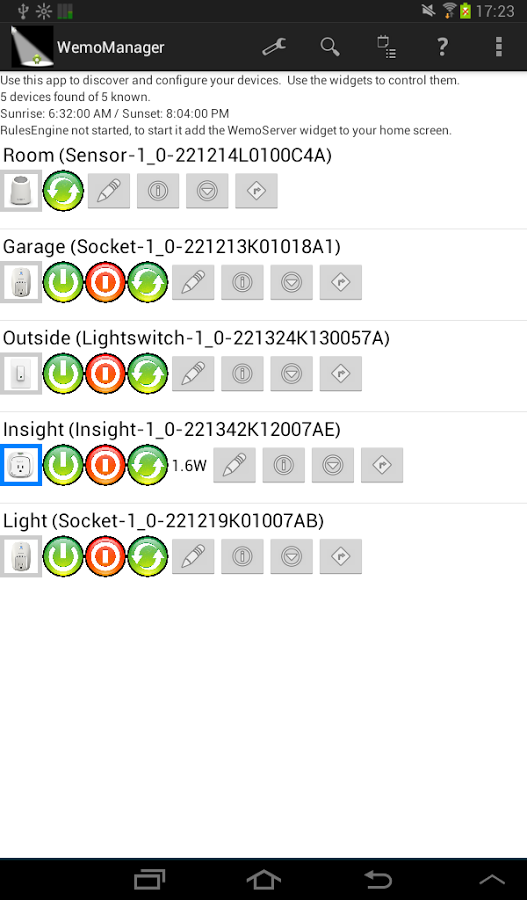Belkin WeMo and Ubiquiti mFi Home Automation Platforms Review
by Ganesh T S on April 27, 2015 8:00 AM EST- Posted in
- Home Automation
- Belkin
- Ubiquiti Networks
- IoT
WeMo Setup and Usage
The WeMo Insight Switch is easy to get up and running, as it just needs to be connected to a power outlet, but the Light Switch is a complicated install due to its in-wall nature. The process is similar to that of the mFi Light Switch & Dimmer. Depending on local regulations, one might need a licensed electrician for the installation. It is important to remember that both these in-wall devices need a neutral wire. Belkin provides a YouTube video with instructions for a DIY install. Just like the mFi InWall light switch, it is good to ensure that there is enough depth and space available in the wall opening to safely install the unit.
The Insight Switch can be controlled directly, thanks to a capacitive on/off touch button on the top. Also, unlike the non-monitoring version, it doesn't block the adjacent port.
WeMo units are setup in a manner similar to the mFi - However, unlike the mFi units where any computing platform with a web browser can be connected to the ad-hoc Wi-Fi network, only smart devices running the WeMo app can be used to setup the units. Belkin's market is for simple setup and operation for unsophisticated users. There are no IP addresses for the users to find or configure, no local web pages, no router changes, no usernames and passwords etc. The authentication is purely via Wi-Fi SSID. The units communicate with Belkin's cloud servers to enable access over the Internet.
The official usage model is through smart devices. The mobile apps allow control and also setting up of rules and scenes. Users can also edit the WeMo devices (names, icons etc.), connect them to IFTTT and export generated data via e-mail / schedule the export (the last point is applicable only to WeMo Insight).
Unfortunately, the WeMo app (the Android version, at least) has been inconsistent over the last year or so. Earlier, I used to be able to set up rules and modify them, but, recently, the app never loads the rules and doesn't allow adding them either. In addition, the energy monitoring aspect of the Insight has become flaky - reading the unit as being on standby even when a load is connected to it.
The division of work between the cloud infrastructure and the local device is not well-documented. We know that WeMo's official APIs communicate via their cloud servers. However, most specific rules (that deal only with that particular device) such as schedules can work independent of the cloud.
MPP App Suite - WemoManager and WemoServer
WeMo, being one of the pioneers in the mass-market home automation ecosystem, piqued the interest of hackers with good intentions. Multiple efforts have gone into deciphering the control protocol and putting it to use in unofficial third-party scripts and applications.
The most comprehensive reverse-engineering / consumer-friendly attempt is Mike's WemoManager / WemoServer. Part of the MPP App Suite, readers must note that the app is not free. The WemoServer does have a free standalone implementation, but requires the WemoManager paid app for extra functionality such as remote access. Mike does deserve recognition for what he has achieved, but, this should have been Belkin's strategy with the WeMo from the beginning (note that Ubiquiti Networks is doing the same thing with the mFi - providing the rules and scenes backend for all devices as a free download that can operate independent of the cloud).
Mike shares many of our thoughts - particularly the aspect that the cloud is probably not the best place to run home automation. It's too slow, occasionally unreliable, and certainly a security risk. As mentioned earlier, Belkin's cloud approach is perfect for unsophisticated users. However, this doesn't mean that power users need to be left out.
Another aspect that we dealt with in our home automation consumer checklist earlier this month was the monetization potential of the cloud. It is likely that Belkin will move to do that in the future - after all, someone needs to pay to keep the cloud servers running and there are no subscription aspects attached to the WeMo devices right now.



















41 Comments
View All Comments
aryonoco - Thursday, April 30, 2015 - link
Fiddly gimmicks. Solutions waiting for a problem.I am not a technophobe. I build my own PCs, run my own NAS, run custom firmware on my router, etc. But I can't, for the life of me, figure out why I need "smart" lights and "smart" power outlets.
Maybe I'm getting old, but as far as I'm concerned, Ganesh and AnandTech are wasting their time reviewing these toys.